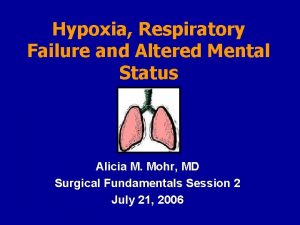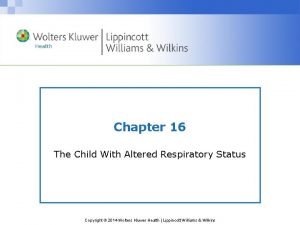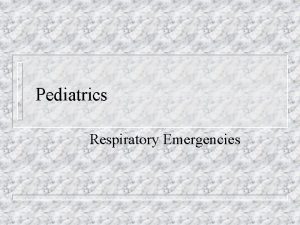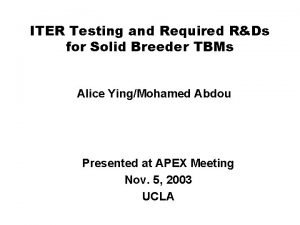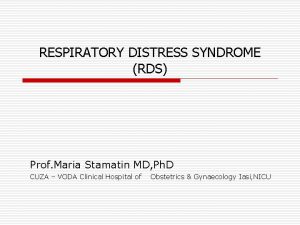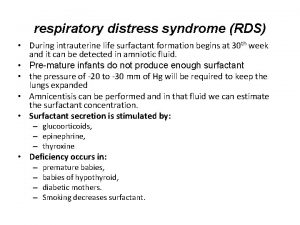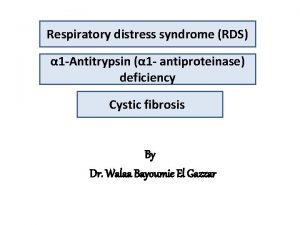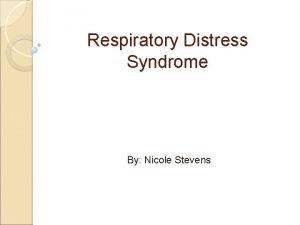Respiratory distress syndrome RDS Respiratory distress syndrome is









- Slides: 9


Respiratory distress syndrome (RDS) • Respiratory distress syndrome: is a clinical syndrome of progressive respiratory insufficiency caused by diffuse alveolar capillary and epithelial damage in the setting of sepsis, severe trauma, or diffuse pulmonary infection. • The histologic manifestation of RDS in the lungs is known as diffuse alveolar damage. • In the acute phase of RDS, the lungs are dark red, firm, airless, and heavy.

Pathogenesis of RDS • The acute consequences of damage to the alveolar capillary membrane include increased vascular permeability and alveolar flooding, loss of diffusion capacity, and widespread surfactant abnormalities. • Under the influence of proinflammatory cytokines such as interleukins IL-8 and IL-1 and tumor necrosis factor (TNF) (released by macrophages), neutrophils initially undergo sequestration in the pulmonary microvasculature, followed by margination and egress into the alveolar space, where they undergo activation. Activated neutrophils release a variety of factors such as leukotrienes, oxidants, proteases, and platelet-activating factor (PAF), which contribute to local tissue damage, accumulation of edema fluid in the air spaces, surfactant inactivation, and hyaline membrane formation. Subsequently, the release of macrophage-derived fibrogenic cytokines such as transforming growth factor-β (TGF-β) and platelet-derived growth factor (PGDF) stimulate fibroblast growth and collagen deposition associated with the healing phase of injury. • Neutrophils and their products have a crucial role in the pathogenesis of RDS by causing endothelial and epithelial injury.

Histological features of RDS • Microscopic examination reveals capillary congestion, necrosis of alveolar epithelial cells, interstitial and intra-alveolar edema and hemorrhage, and (particularly with sepsis) collections of neutrophils in capillaries. The most characteristic finding is the presence of hyaline membranes, particularly lining the distended alveolar ducts. Such membranes consist of fibrin-rich edema fluid admixed with remnants of necrotic epithelial cells. Normal lung tissue Diffuse alveolar damage in RDS. Some alveoli are collapsed; others are distended. Many are lined by bright pink hyaline membranes (arrow).

Bronchial asthma • Asthma is a chronic inflammatory disorder of the airways that causes recurrent episodes of wheezing, Normal airway breathlessness, chest tightness, and cough, particularly at night and/or early in the morning. The hallmarks of the disease are intermittent and reversible airway obstruction, chronic bronchial inflammation with eosinophils, bronchial smooth muscle cell hypertrophy and hyperreactivity, and increased mucus secretion. • Many cells play a role in the inflammatory response, in particular eosinophils, mast cells, macrophages, Airway in Asthma lymphocytes, neutrophils, and epithelial cells. • Note: the accumulation of mucus in the bronchial lumen resulting from an increase in the number of mucussecreting goblet cells in the mucosa and hypertrophy of submucosal glands. In addition, there is intense chronic inflammation due to recruitment of eosinophils, macrophages, and other inflammatory cells. Basement membrane underlying the mucosal epithelium is thickened, and smooth muscle cells exhibit hypertrophy and hyperplasia.

Pathogenesis of Asthma Triggering of Asthma • Inhaled allergens (antigens) elicit a TH 2 -dominated response favoring Ig. E production and eosinophil recruitment (priming or sensitization). On reexposure to antigen (Ag), the immediate reaction is triggered by antigen-induced cross-linking of Ig. E bound to Ig. E receptors on mast cells in the airways. These cells release preformed mediators. Collectively, either directly or through neuronal reflexes, the mediators induce bronchospasm, increase vascular permeability and mucus production, and recruit additional mediator -releasing cells from the blood. The arrival of recruited leukocytes (neutrophils, eosinophils, basophils, lymphocytes, and monocytes) signals the initiation of the late phase of asthma and a fresh round of mediator release from leukocytes, endothelium, and epithelial cells. Factors, particularly from eosinophils (e. g. , major basic protein, eosinophil cationic protein), also cause damage to the epithelium. Immediate phase Late phase

Emphysema • Emphysema is characterized by abnormal permanent enlargement of the air spaces distal to the terminal bronchioles, accompanied by destruction of their walls without significant fibrosis. • Emphysema is classified according to its anatomic distribution within the lobule, the acinus is the structure distal to terminal bronchioles, and a cluster of three to five acini is called a lobule. There are four major types of emphysema: (1) centriacinar, (2) panacinar, (3) distal acinar, and (4) irregular. Major patterns of emphysema. A, Diagram of normal structure of the acinus, the fundamental unit of the lung. B, Centriacinar emphysema with dilation that initially affects the respiratory bronchioles. C, Panacinar emphysema with initial distention of all the peripheral structures (i. e. , the alveolus and alveolar duct); the disease later extends to affect the respiratory bronchioles.

Pathogenesis of Emphysema • Exposure to toxic substances such as tobacco smoke and inhaled pollutants induces ongoing inflammation with accumulation of neutrophils, macrophages and lymphocytes in the lung. Elastases, cytokines (including IL-8) and oxidants are released causing epithelial injury and proteolysis of the extracellular matrix (ECM). Elastin degradation products further increase the inflammation. Unless checked by antielastases (e. g. , α 1 -antitrypsin) and antioxidants, the cycle of inflammation and ECM proteolysis continues. • There is marked individual variation in susceptibility to the development of emphysema. Multiple genetic factors control the response to injury after smoking. For example, the TGFB gene exhibits polymorphisms that influence susceptibility to the development of emphysema by regulating the response of mesenchymal cells to injury. For example, with certain polymorphisms, mesenchymal cell response to TGF-β signaling is reduced, which in turn results in inadequate repair of elastin injury caused by inhaled toxins. Matrix metalloproteinases (MMPs), especially MMP-9 and MMP-12, have also been shown to have a pathogenic role in emphysema. MMP-9 gene polymorphisms and higher levels of both MMP-9 and MMP-12 have been found in some emphysema patients. • In emphysema there is loss of not only epithelial and endothelial cells but also mesenchymal cells, leading to lack of extracellular matrix, the scaffolding upon which epithelial cells would have grown.

Features of Emphysema • The diagnosis and classification of emphysema depend largely on the macroscopic appearance of the lung. • Histologic examination reveals destruction of alveolar walls without fibrosis, leading to enlarged air spaces. • In addition to alveolar loss, the number of alveolar capillaries is diminished. Terminal and respiratory bronchioles may be deformed because of the loss of septa that help tether these structures in the parenchyma. With the loss of elastic tissue in the surrounding alveolar septa, radial traction on the small airways is reduced. • Bronchiolar inflammation and submucosal fibrosis are consistently present in advanced disease. Pulmonary emphysema. There is marked enlargement of air spaces, with destruction of alveolar septa but without fibrosis. Note: presence of black anthracotic pigment.
